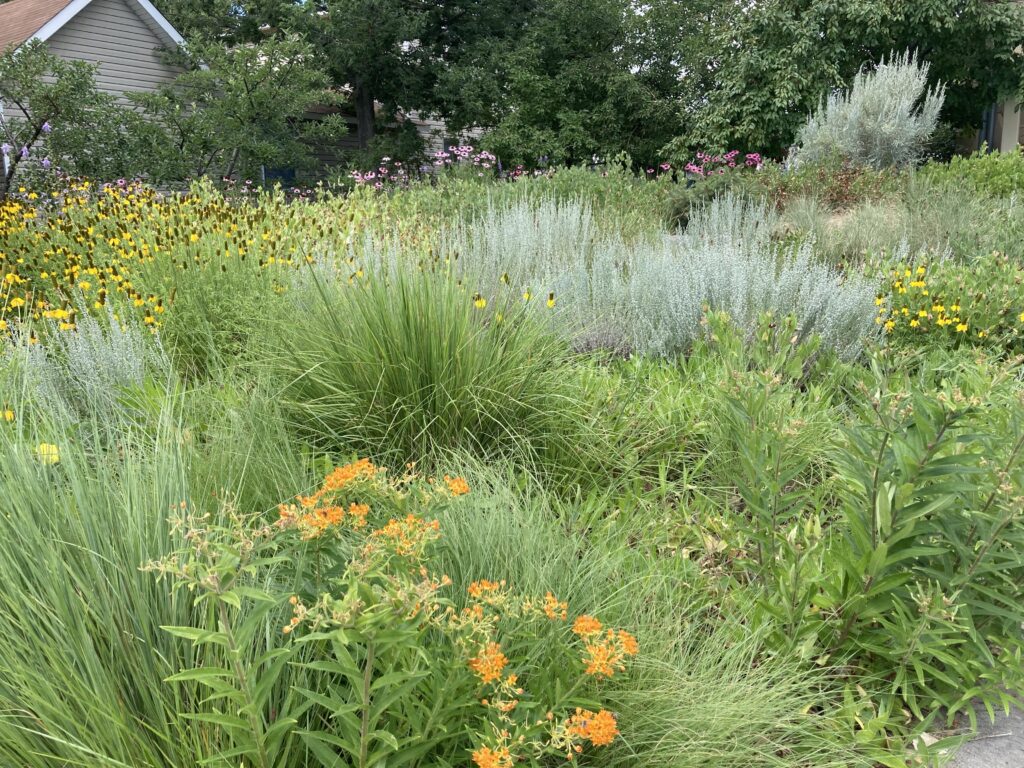By Ayn Schmit

One of the first goals for many gardeners new to landscaping with native plants is to rid their landscape – in part or entirely – of non-native turf. Doing so is a no-brainer! Non-native turf grasses are ecological dead zones, they require large amounts of water, and often prompt gardeners to use fertilizer and herbicides to ensure turf is lush and weed-free. Non-native turf also provides an excellent overwintering environment for Japanese beetle grubs, which will then emerge to eat foliage and flowers of other plants in the summer. Around half of the water used in Denver during irrigation season goes to outdoor use – much of it to watering Kentucky bluegrass or KBG, which incidentally is from Eurasia (not from Kentucky and not native to North America). So, time to roll up your gardening sleeves and convert your non-native turf to native alternatives.
Setting Turf Replacement Goal and Choosing Turf Removal Approach
Whether you have a few hundred square feet or acres of turf, set a realistic goal for turf replacement before you embark on your project. For large areas, it may make sense to approach it incrementally over time – start small and expand your effort over time, learning what works best for you as you go. It is also important to consider what you’d like to replace the turf with. Are you looking for native turf alternatives? Colorado has wonderful native grasses to choose from. Do you want to be able to walk and run on the replacement plants? Do you want to mow the replacement plants or simply let them grow? Or is your preference to replace turf with flowering plants to provide more diverse pollinator habitat?
Approaches to Removing Non-Native Turf
There are a few basic approaches to removing turf that offer differing pros and cons.
Smothering
This involves covering the turf removal area with a continuous layer of clean cardboard. The cardboard is then covered with organic mulch (wood chips or crushed leaf mulch) or non-organic mulch (gravel), depending on the post-turf plan for the area. The cardboard must be left in place for several months during the growing season. The cardboard can be left in place and planted through if desired.
Solarizing
This involves covering grass with clear plastic (some use black plastic, which doesn’t seem to work as well). The greenhouse effect created by the plastic will kill the turf though may allow some of the tougher weeds to survive. This also takes a full growing season to work effectively.
Sod Removal
This involves removing the top 8” of turf by hand or with a sod cutter. Sod removal is quicker than the first two but may require a second round of removal to capture all the turf, and the removed turf and topsoil will need to be disposed of. This also disturbs the soil much more than the other methods, which has its drawbacks.
Following implementation of one of these methods, there will still be weeds or remnant turf that will need to be managed to create a ‘clean slate’ for replacement plants. This can be accomplished through mechanical weed removal or the use of a herbicide. The toolkit describes these options in more detail.
What Comes Next? Choosing Native Lawn Alternatives
While you may choose to replace your turf with flowering plants, prairie, shrubs or other non-turf alternatives, many people are interested in retaining at least some lawn-like space for kids or pets to run and play on. The good news is, there are some good native alternatives. The native grass most tolerant of foot traffic is buffalograss (Buchloe dactyloides). It is a warm season grass that tolerates light-moderate foot traffic or occasional heavy traffic. It can be challenging to establish but once established it can survive without irrigation, although CSU recommends irrigation every 2-4 weeks for optimal results. It can be mowed or left unmowed. It will green up later in the spring and looks best in the May-September time frame. Other options include our state grass blue grama (Bouteloua gracilis), which is less tolerant of foot traffic but a beautiful option for infrequent traffic areas.
As we look ahead to spring and summer, make a plan to remove some turf and replace it with native options that sustain our pollinators and wildlife and conserve our precious water (not to mention offer climate resilience benefits)! We will have more information on this topic in the Toolkit Section on Turf Removal and Replacement, with additional resources referenced there, in the next few months.
Curious to learn more about transforming your garden into a habitat with Colorado native wildflowers, grasses, shrubs, and trees? Check out our native gardening toolkit, register for an upcoming event, subscribe to our newsletter, and/or become a member – if you’re not one already!
